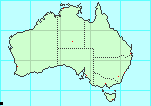
Common Name:
Delete this section if there is no common name.
Identification:
Length:
Coloring:
Note any distinguishing features.
| body | 70 mm.;
width do., 1.5-3 mm. |
| head | 4.5 mm. |
| pronotum | 3.5 mm. |
| mesonotum | 17 mm. |
| metanotum | 11 mm. |
| abdomen | 35 mm. |
| ant. femora | 17 mm. |
| ant. tibiæ | 16 mm. |
| med. femora | 14 mm. |
| med. tibiæ | 16 mm. |
| post. femora | 20 mm. |
| post. tibiæ | 16 mm. |
| tarsi | 3.5 mm. |
Male.
Brownish-grey, glabrous, with more or less distinct black, or blackish,
median line or markings dorsally from transverse carina at back of head
to fifth abdominal segment.
Head a little longer than pronotum, tumid behind antennæ, with a
raised flat spot in place of the obsolete central ocellus, and two short
divergent ridges lateral thereof.
Eyes elliptical, small, scarcely prominent.
Antennæ grey, triquetrous (terminal portion wanting).
Pronotum rotundately arched above, median line slightly, lateral carina
more deeply impressed, transverse carina a little anterior to middle,
hind margin narrowly black.
Mesonotum slightly wider than head, sides parallel throughout, median
line raised, dorsum along the middle with numerous blackish, irregularly
scattered dots; lateral carina rather broad, extending for three-fourths
of length, brown, externally to same a blackish line extending to hind
margin, and forming the crest of a low, broad ridge.
Metanotum of same width, or only slightly wider, as the preceding, and
of similar structure, but darker brown, and the aggregated dots forming
a broad dark median stripe.
Abdomen with segments, 1 to 3 subequal and of same width as thorax,
4 to 6 somewhat narrower, and much longer, tapering, next three still
more slender, short (two subequal, the third scarcely more than half
the length of the preceding), last joint with supra-anal lamina very
short, latter with closely adpressed edges, forming a ridge, subacute,
and longer than preceding segment.
Subgenital lamina boat-shaped, last joint finely rugose, apex ovate,
whitish.
Cerci very short, concealed.
Legs comparatively short and weak, unarmed, scabrous, grey.
 Note parental placement of eggs.
Note appearance of eggs.
Note any common variations.
Note parental placement of eggs.
Note appearance of eggs.
Note any common variations.
Habitat:
Note if the species arborial or terrestrial.
Canopy, mid, under, etc.
Note typical vegetation, e.g.
tropical rainforest, temperate rainforest,
grasslands,
alpine, etc.
Similar Species:
Rearing Notes:
Note if this species has ever been reared.
Note any suggestions for successful rearing.
For a stick insect with body length 70mm, to keep 2 adult females,
you need a cage at least 350mm high, 140mm deep and 140mm wide.
 Range:
Range:
W plateau, SA
Status:
It is not known if this species is endangered,
as there is insufficient sighting history.
References:
-
Balderson, J., Rentz,
D.C.F. and Roach, A.M.E. (1998).
in
Houston, W.K.K. & Wells, A. (1998) (eds)
Zoological Catalogue of Australia.
Vol. 23.
Archaeognatha, Zygentoma, Blattodea, Isoptera, Mantodea, Dermaptera,
Phasmatodea, Embioptera, Zoraptera.
Melbourne: CSIRO Publishing, Australia (ISBN 0643 06035 9).
pp. 347 - 376.
-
Tepper, J.G.O. (1905).
Insects collected in the North-western Region of South Australia Proper
by H. Basedow; with Descriptions of New Species of Mantidæ and
Phasmidæ, No. 2.
Transactions of the Royal Society South Australia, 29: 237-245.
-
Vickery, V.R. (1983).
Catalogue of Australian stick insects (Phasmida,
Phasmatodea, Phasmatoptera, or Cheleutoptera). CSIRO
Australian Division of Entomology Technical Paper, No. 20, 15 pp.
- Search Google for
Lonchodes caurus,
or search Google Scholar for
Lonchodes caurus.
Copyright © 2000-2003
Peter Miller
This page was last changed 20-Sep-2006.
|

|

|
 Note parental placement of eggs.
Note appearance of eggs.
Note any common variations.
Note parental placement of eggs.
Note appearance of eggs.
Note any common variations.

 Note parental placement of eggs.
Note appearance of eggs.
Note any common variations.
Note parental placement of eggs.
Note appearance of eggs.
Note any common variations.
 Range:
Range: 
